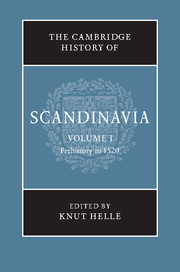Book contents
- Frontmatter
- Introduction
- PART I THE GEOGRAPHY AND PREHISTORY OF SCANDINAVIA
- PART II FROM VIKINGS TO KINGS
- 5 The Viking expansion
- 6 Viking culture
- 7 Scandinavia enters Christian Europe
- 8 Early political organisation
- (a) Introductory survey
- (b) The making of the Danish kingdom
- (c) The early unification of Norway
- (d) The Norse island communities of the Western Ocean
- (e) Kings and provinces in Sweden
- PART III MATERIAL GROWTH (to c. 1350)
- PART IV THE HIGH MEDIEVAL KINGDOMS
- PART V HIGH AND LATE MEDIEVAL CULTURE
- PART VI LATE MEDIEVAL SOCIETY (c. 1350–1520)
- PART VII SCANDINAVIAN UNIONS (1319–1520)
- Conclusion
- Select bibliography: primary sources, general surveys and secondary works arranged by part
- Index
- Plate Section"
- References
(e) - Kings and provinces in Sweden
from 8 - Early political organisation
Published online by Cambridge University Press: 28 March 2008
- Frontmatter
- Introduction
- PART I THE GEOGRAPHY AND PREHISTORY OF SCANDINAVIA
- PART II FROM VIKINGS TO KINGS
- 5 The Viking expansion
- 6 Viking culture
- 7 Scandinavia enters Christian Europe
- 8 Early political organisation
- (a) Introductory survey
- (b) The making of the Danish kingdom
- (c) The early unification of Norway
- (d) The Norse island communities of the Western Ocean
- (e) Kings and provinces in Sweden
- PART III MATERIAL GROWTH (to c. 1350)
- PART IV THE HIGH MEDIEVAL KINGDOMS
- PART V HIGH AND LATE MEDIEVAL CULTURE
- PART VI LATE MEDIEVAL SOCIETY (c. 1350–1520)
- PART VII SCANDINAVIAN UNIONS (1319–1520)
- Conclusion
- Select bibliography: primary sources, general surveys and secondary works arranged by part
- Index
- Plate Section"
- References
Summary
The territorial unification of Sweden started later and generally progressed more slowly than that of Denmark and Norway; it may be said to have lasted from about AD 1000 to about 1250. Partly because of the scarcity of written evidence it has been customary to regard the whole of this period and the following years to 1319 as the early Middle Ages of Sweden, including most of what in this volume is defined as the central or high Middle Ages of Scandinavia (see Introduction).
The core of the medieval kingdom comprised its two main regions, Svealand and Götaland, the most populous and densely settled parts of modern Sweden as they must have been in Swedish prehistory. Kings who, in the course of the eleventh and twelfth centuries, gained some degree of control over these regions, also began to bring peripheral regions under their authority. In the course of this process political and social structures were transformed. The capacities of kingship expanded and a rudimentary form of public power emerged.
The core of the old Svealand were the districts around Lake Mälaren, whereas Götaland was centred on the plains of Östergötland and Västergötland further south, to the east and west of Lake Vättern respectively. Impenetrable forests divided the two regions from each other. From Tacitus onwards classical and early medieval writers now and then mention peoples or tribes in present-day Sweden, notably Svear and Götar. These terms should not be interpreted exclusively as names of ethnic groups. The Svear are more frequently mentioned in foreign sources than the Götar because they were identified with seaborne military activities.
Keywords
- Type
- Chapter
- Information
- The Cambridge History of Scandinavia , pp. 221 - 234Publisher: Cambridge University PressPrint publication year: 2003
References
- 22
- Cited by

